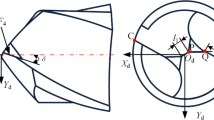Abstract
Helical drill point is characterized by a continuous helical flank surface and an S-shape chisel edge, and its special geometry contributes to a superior drilling performance and a better grinding efficiency. However, the existing grinding processes are complicated and hard to be reproduced in practice, and it is difficult to meet the accuracy requirements as the drill diameter becomes smaller. Thus, it is crucial to research further grinding method of helical micro-drill and its drilling performance. In this paper, a grinding method of helical drill flank using a six-axis CNC grinding machine is proposed based on the mathematical model of generatrix of the helical surface. Then, this grinding process is simulated using the 3D CAD software and is validated by experimentally fabricating the helical micro-drill. The results show that this method is feasible for obtaining the micro-drill with high dimensional accuracy. For the comparison with helical micro-drill, the planar and conical micro-drills with the same geometry parameters are produced as well. The drilling experiments on 1Cr18Ni9Ti austenitic stainless steel with the planar, conical, and helical micro-drills are conducted, and the drilling force, tool wear, and hole quality are measured and analyzed. The experiment results show that the increasing rate of the radial force of helical micro-drills at the beginning of the drilling process is smaller than those of planar and conical micro-drills, the thrust force and wear of helical drill point are also smaller, and the quality of micro-holes by helical drill point is better as well. It is confirmed that the proposed grinding process is effective to fabricate the helical micro-drill with good drilling performance.
Similar content being viewed by others
References
Galloway DF (1957) Some experiments on the influence of various factors on drill performance. Trans ASME 79:191–231
Chyan HC, Ehmann KF (1998) Development of curved helical micro-drill point technology for micro-hole drilling. Mechatronics 8(4):337–358
Fugelso MA (1990) Conical flank twist drill points. Int J Mach Tools Manuf 30(2):291–295
Fugelso MA (1983) Cylindrical flank twist drill points. ASME J Eng Ind 105(3):183–186
Tsai WD, Wu SM (1979) Computer analysis of drill point geometry. Int J Mach Tool Des Res 19(2):95–108
Wu SM, Shen JM (1983) Mathematical model for multifacet drills. ASME J Eng Ind 105(3):173–182
Lin C, Kang SK, Ehmann KF (1992) Planar micro-drill point design and grinding methods. Transactions of the North American Manufacturing Research Institution of SME XX:173–179
Lee AC, Nguyen DT, Wu GT (2014) Analyses of a new four-facet drill. Int J Adv Manuf Technol 75(1):411–424
Lin C, Kang SK, Ehmann KF (1995) Helical micro-drill point design and grinding. ASME J Eng Ind 117(3):277–287
Zhou ZX (2000) A kind of new micro-drill and grinding technology. PhD thesis, Hunan University, China
Kang SK (1993) Micro-drill geometry and grinding. PhD thesis, Northwestern University, USA
Ganglani S, Ehmann KF (2001) Design and implementation of a helical drill point grinder. Trans NAMRI/SME XX|X:1–8
Fetecau C, Stan F, Oancea N (2009) Toroidal grinding method for curved cutting edge twist drills. J Mater Process Technol 209(7):3460–3468
Hsieh JF (2005) Mathematical model for helical drill point. Int J Mach Tools Manuf 45(7–8):967–977
Hsieh JF (2008) NC data generation for 6-axis machine tools to produce a helical drill. Int J Adv Manuf Technol 36(5):535–546
Kang SK, Lin C, Ehmann KF (1993) Comparative analysis of planar and helical micro-drill points. Trans NAMRI/SME XXI:189–196
Dornfeld DA, Kim JS, Dechow H, Hewsona J, Chenb LJ (1999) Drilling burr formation in titanium alloy, Ti-6AI-4V. CIRP Ann-Manuf Technol 48(1):73–76
Jurko J, Panda A, Behún M, Berdis A, Gecák J, Gecík M, Orendáč P (2012) Helical drills wear during drilling of a new ELC austenitic stainless steels. Appl Mech Mater 217–219:2202–2205
Yan L, Jiang F (2013) A practical optimization design of helical geometry drill point and its grinding process. Int J Adv Manuf Technol 64(9):1387–1394
Paul A, Kapoor SG, DeVor DE (2005) Chisel edge and cutting lip shape optimization for improved twist drill point design. Int J Mach Tools Manuf 45(4–5):421–431
Xiang WJ, Zhou ZX (2006) Analysis and solution of NC grinding parameter for new helical micro-drill point. Tool Eng 40(4):51–53
Author information
Authors and Affiliations
Corresponding author
Rights and permissions
About this article
Cite this article
Zhang, S., Liang, Z., Wang, X. et al. Grinding process of helical micro-drill using a six-axis CNC grinding machine and its fundamental drilling performance. Int J Adv Manuf Technol 86, 2823–2835 (2016). https://doi.org/10.1007/s00170-016-8359-0
Received:
Accepted:
Published:
Issue Date:
DOI: https://doi.org/10.1007/s00170-016-8359-0




